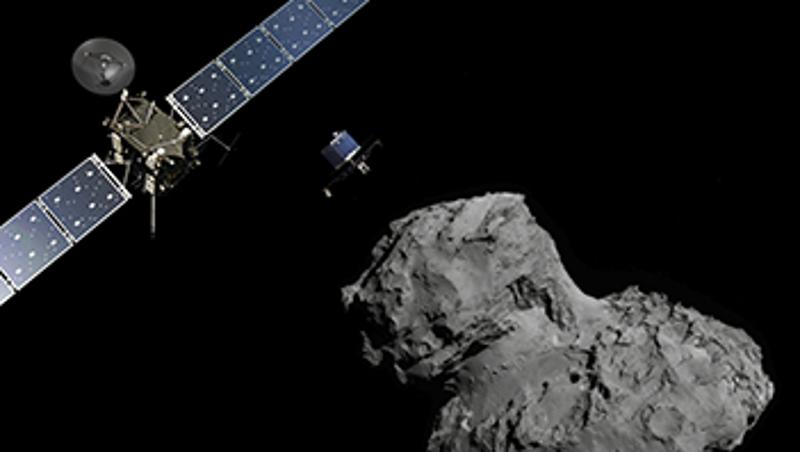
Why has the European Space Agency spent more than a decade working out how to land a robot on any icy comet?
Because the information it gathers will tell us more about Earth's dark past, including where at least some of our water came from, according to QUT astrophysicist Dr Stephen Hughes.
Rosetta mission - fast facts:
•First comet landing in history - and it's a robot.
•Touches down at 1.30am (Queensland time) this Thursday.
•Mission will tell us about how the Earth formed, and where its water came from.
•Rosetta uses 'cricket physics' to get to comet.
•Probe needs screws and harpoons to grab hold of comet in negligible gravity.
•An interactive map of Rosetta's journey.
On Wednesday evening, Queensland time, the ESA's Rosetta spacecraft will release its robotic probe, Philae, and land it on comet 67P/ Churyumov Gerasimenko (67P/C-G).
It's the first time humanity has tried to land a probe on a comet, and scientists around the world will be watching keenly.
Dr Hughes said the ESA's Rosetta mission would help solve some of the mysteries about how the solar system was formed.
"Comets carry a record of conditions in the solar system at the time when the Earth was formed," said Dr Hughes, from QUT's Science and Engineering Faculty.
"In some ways, comets are like bricks left on a building site long after the building is completed. We have high hopes the Rosetta mission will allow scientists to 'read' one of these bricks to obtain information about the formation of the Earth.
"In particular, the Philae lander will analyse the type of water making up the icy comet by looking at the ratio of deuterium to hydrogen.
"If the water on 67P/C-G is similar to the water on the Earth, this may indicate at least some of Earth's water was supplied by comets in the early days of the solar system."
Dr Hughes said the Philae probe was packed with 10 instruments to analyse the composition of 67P/C-G.
Once released from Rosetta on 12 November, it will take seven hours to descend 20.5 kilometres to the comet's surface.
"The gravity of 67P/C-G is only a ten-thousandth of Earth's - so weak that Philae will 'hit' the surface at one kilometre per second - slow walking speed," Dr Hughes said.
"What would that weak gravity feel like? A 100 kilogram person would weight just 100 grams on 67P/C-G; if you dropped a glass from one metre above 67P/C-G's surface, it would take 45 seconds to hit the ground.
"The comet's weak gravity will be problematic for the ESA - Philae could easily bounce off and be lost in space.
"ESA scientists face another slight complication: the comet spins on its axis once every 12.4 hours (the length of the day on 67P/C-G) and the probe will have to factor that spin in as it descends."
Dr Hughes said the ESA had devised special landing manoeuvres to prevent Philae from bouncing off 67P/C-G.
As soon as the first of its three legs touches the comet, Philae will drill a screw from that leg into 67P/C-G's surface. At the same time a rocket on the probe's roof will fire, pushing the probe downwards.
"Soon after, two harpoons will fire from underneath the probe into the icy surface," Dr Hughes said.
"Finally screw drills in the probe's other two legs will drill in when they touch. Hopefully, with all these backup systems, Philae will be able to hold limpet-like on 67P/C-G."
Rosetta, Philae and 67P/C-G are currently about 449 million kilometres from the Sun, between the orbits of Mars and Jupiter.
At that distance, the comet is still in a 'deep freeze'.
Dr Hughes said Rosetta and Philae will follow 67P/C-G towards the Sun, watching the comet warm up as it reaches its closest point to the Sun on 13 August 2015.
It has taken the spacecraft a little more than 10 years to reach 67P/C-G, having meandered 6.4 million kilometres - roughly the distance between Pluto and the Sun.
"Rosetta didn't travel in a straight line but, rather, followed a circuitous route in the solar system, using Mars and the Earth to increase the speed of the craft - a technique called 'gravity assist'," Dr Hughes said.
"It's essentially 'cricket physics', in which the spacecraft is the ball and the planets are the bats.
"A space probe increases its speed when 'hit' by a planet moving in the opposite direction. It picks up energy from the planet and so needs much less fuel to complete its journey."
Philae is due to land on 67P/C-G at around 1.30am, Queensland time, on Thursday 13 November.
Watch this interactive map of the Rosetta's journey, which includes its route and milestones. Watch a live data feed from the comet.
More ESA images of 67P/C-G are available on the ESA website; most can be used for media purposes (copyright information).
About 67P/C-G
•4 km diameter, shaped like a rubber duck
•10 billion tons
•Discovered in 1969
•Named after its discoverers, Russian astronomers from Kiev called Klim Churyumov and Svetlana Gerasimenko
•"P" in its name identifies it as a short-period comet, (orbits the Sun in less than 200 years)
•Orbits the Sun every 6.45 years
•One day on 67P/C-G is 12.4 hours
Media contacts:
Kate Haggman, QUT Media, 07 3138 0358, kate.haggman@qut.edu.au
After hours Rose Trapnell, QUT Media team leader, 0407 585 901




